New York City's Department of Design & Construction
Exploring New York City's Construction Sites & the communities outlook towards it.
Ethnographic Research

Background
New York City Department of Design and Construction is the department of the government of New York City that builds many of the civic facilities in New York City.
This case study was conducted to assess the what people and community members percieve about construction and how can we bridge the gap between the New York City’s Department of Design & Construction.
We conducted research to assess and analyze the thought process, sentiments and feelings towards the construction sites of New York City.
My Role
User Experience Researcher
Skills
UX Research
Duration
14 Weeks
Tools
Figma, Miro
Our Team

Our Process
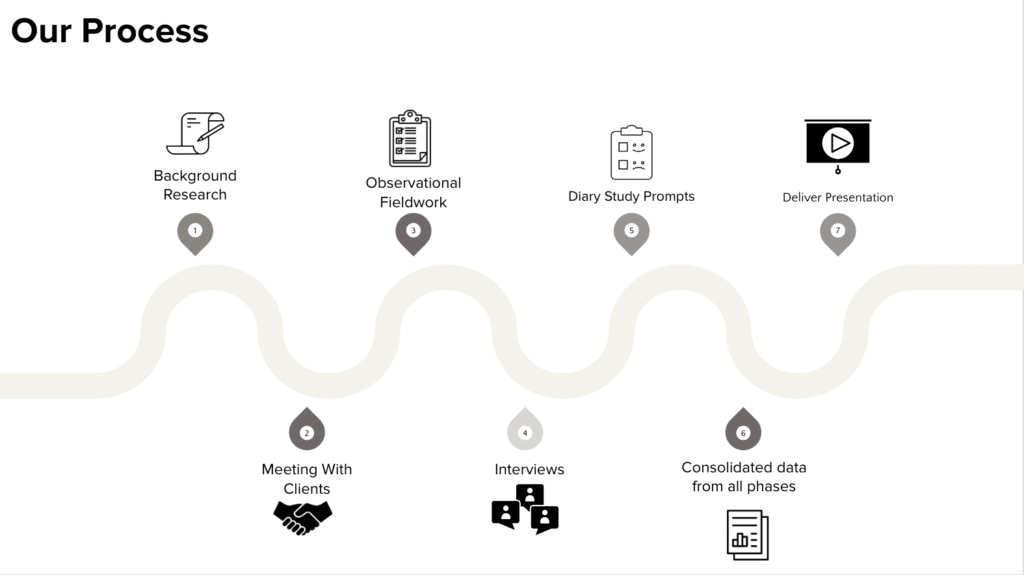
Meeting with Client
Background Research
In order to begin with our research, It was important that we first understand the client needs and goals.
We did our research by reading up on the previous projects that DDC has conducted and completed emphasizing on the process and approach taken earlier.
We focused on the objective, methodology , findings conducted earlier which led us to start the first kick-off meeting with knowledge about previous work and our own question for the client.
Meeting with Client
Understanding Client Goals
What are they responsible for?
They build many of the civic facilities New Yorkers use every day. We provide communities with new or renovated structures such as firehouses, libraries, police precincts, courthouses, senior centers and more.
We provide sidewalks, street reconstruction, water mains, sewers, and pedestrian ramps, quality infrastructure that is essential for a healthy, resilient city in all five boroughs.
What are their goals?
- Complete projects on time and within budget.
- Meet quality assurance and site safety standards for all active projects.
- Improve customer satisfaction ratings.
- How to provide up-to-date information about the city’s ongoing subsurface construction projects to NYC residents and visitors.
Observations & Analysis
Fieldwork
Gaining insight of into our client
Objective:
Understanding the culture, values, norms, or social environment of an individual or group.
This was the first phase of our research project which involved us going to specific construction sites and observing the environment, the vibe, mood and how people are interacting with the construction site.
Observations & Analysis
Fieldwork
We developed a few themes from our observations from the Greenwich Construction site:
Parking is a hassle:
- Firstly, we learned that one of the biggest inconveniences residents face as a result of the construction is parking. The construction site ends up blocking off the area where residents and shoppers would typically park their cars, meaning that residents and shoppers have to park awkwardly beside the construction barriers and fences instead.
People adapted to the environment:
- Residents and pedestrians adapted to the construction site environment. People were leaning against the construction barriers to rest, and holding onto the fences for support. In addition, people started to cross the street diagonally, rather than following the zebra crossing, so that they could be easily seen by cars as they drove around the corner.
Information about the construction site is not easy to find:
- We observed that information regarding the construction was not easily sightable. It took us a while to spot the poster inside the construction site, which can be easily missed by passersby, commuters, or residents.
- The contents of the poster make it seem that the city has identified the pain points of the people and hence will coordinate with private utility companies. This also means that the construction will be underground. However, there is no mention of the duration of the project. No point of contact is mentioned. Just a number provided in case of non-emergency city services.
Observations & Analysis
Interviews
Gaining insight of into our client
Objective:
Learn more about people’s experience with street construction projects.
We interviewed a few people at our designated construction site in order to understand their perspective, through process and if the construction site affects them in any manner.
Observations & Analysis
Interviews
Amongst the interviews we conducted, here are snippets of two which gives us an insight auto the common issues faced by people in relation to the construction project. We also interviewed residents, tourists who gave us their perspective as well.
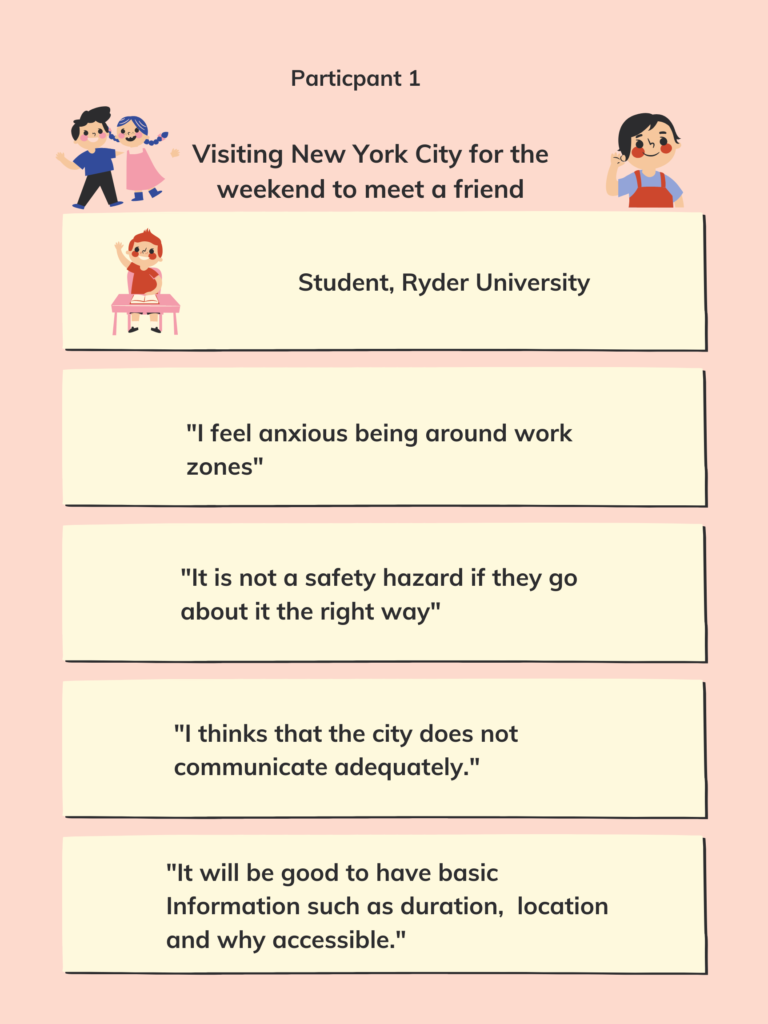
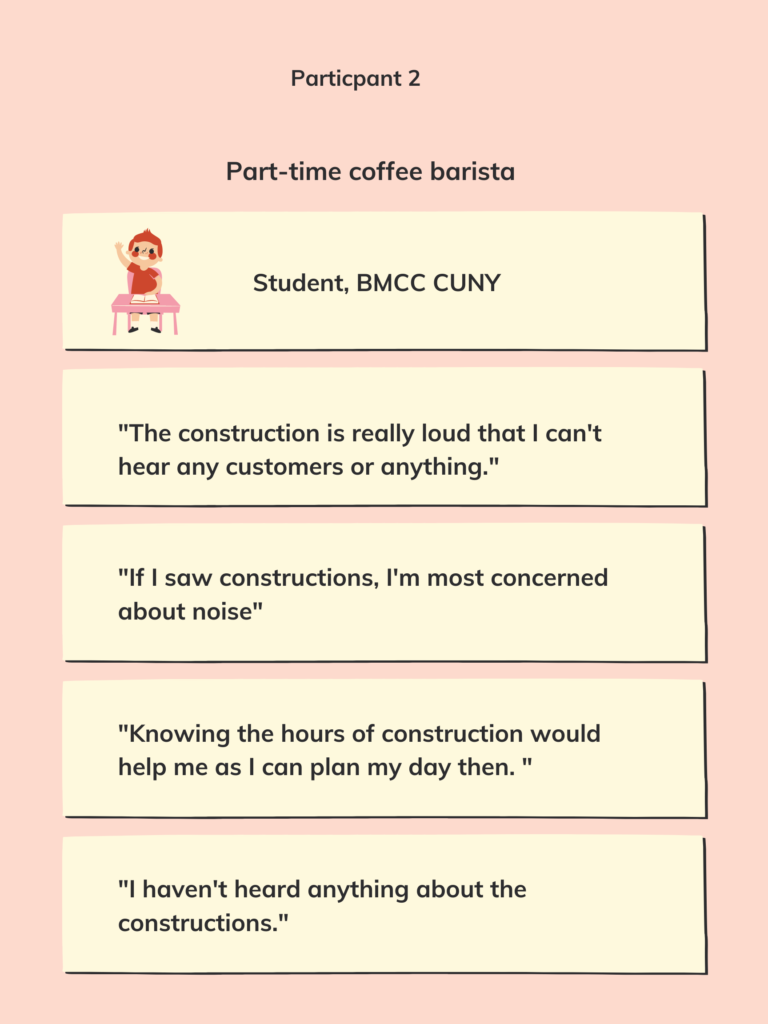
Analysis Of Raw Data
Developing Themes
Accessible communication
- New Yorkers want more communication about street construction in the form of updates via a website, flyers, and social media + an option of multi-language. They want to be informed about the duration and the changes being made. They want to be more involved and kept in the loop.
Visual Rendering + Site information
- New Yorkers want to know what the construction would look like once completed, the duration of construction, why it’s being done, which areas are affected, and when construction is going on.
Developing Prompts
Observing Users From A Distance
Our second phase in our research study was to conduct diary study which would allow us to understand:
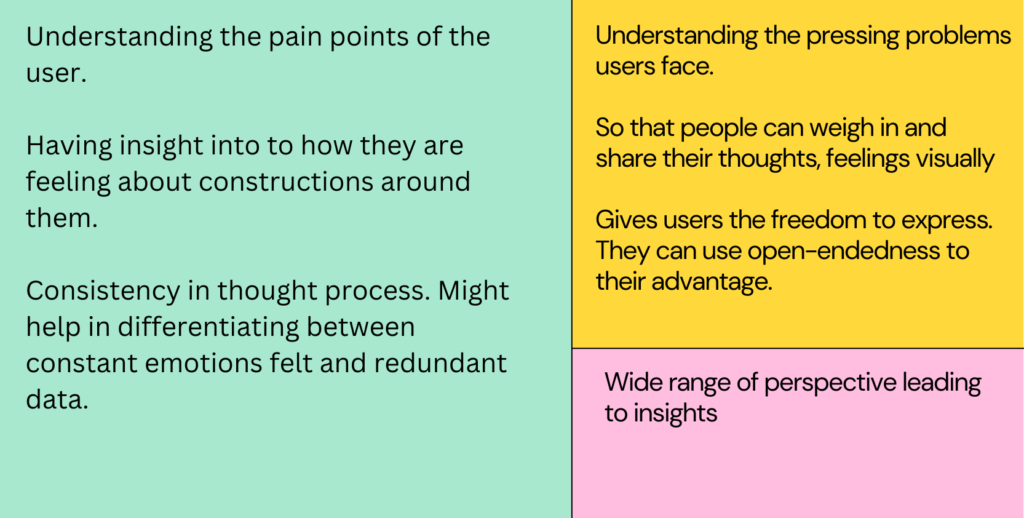
Developing Prompts
Engaging Users
Collaboratively we came up with prompts to our conduct diary studies.

We decided to come up with three different kinds of prompts which would engage our users and particpants in different ways. We would be engaging them in Mood-boarding, Magic Wand, Time Machine letting us know how they feel and how do they want to feel.
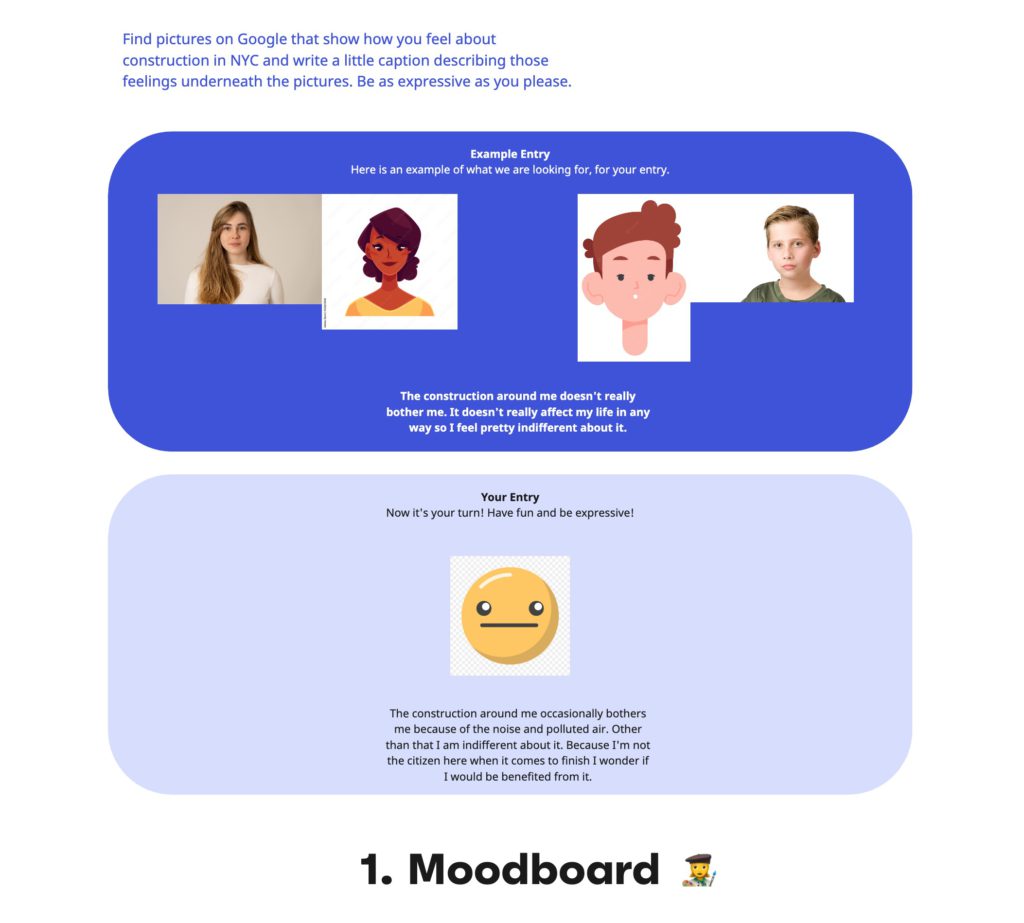
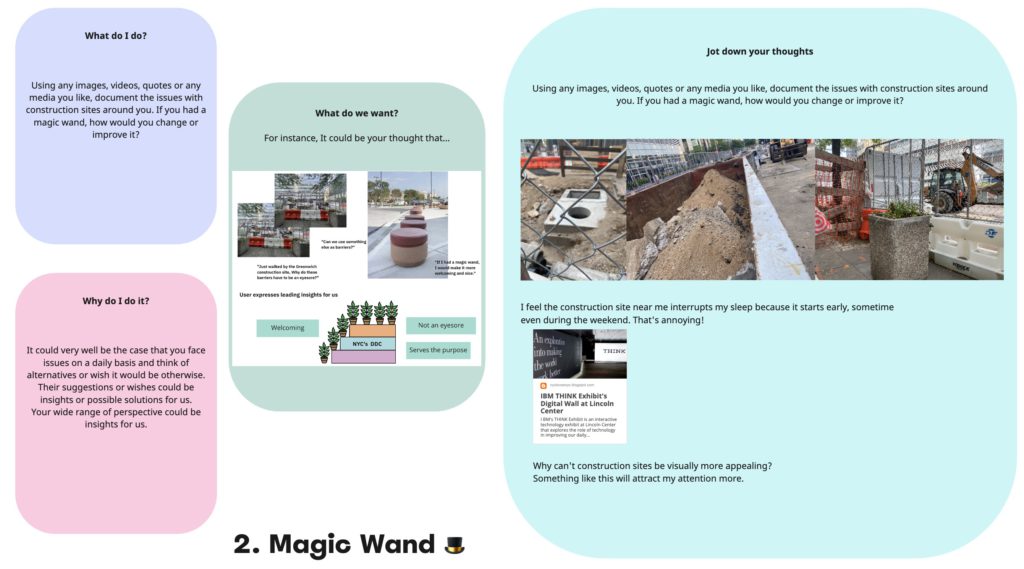
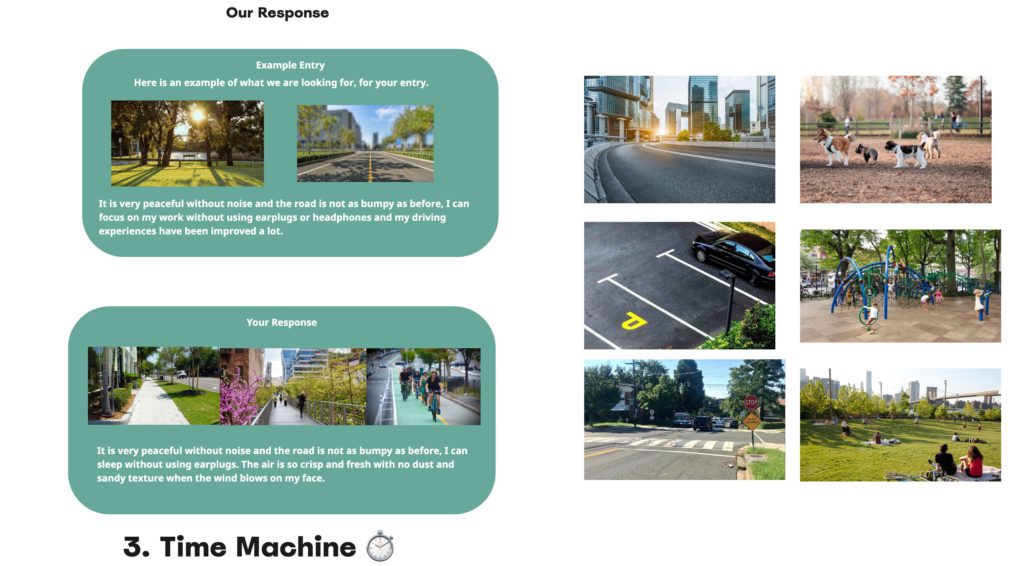
Client Check-In
A Day-In-The-Life Story
We recorded our responses from the diary study which led us to our analysis.
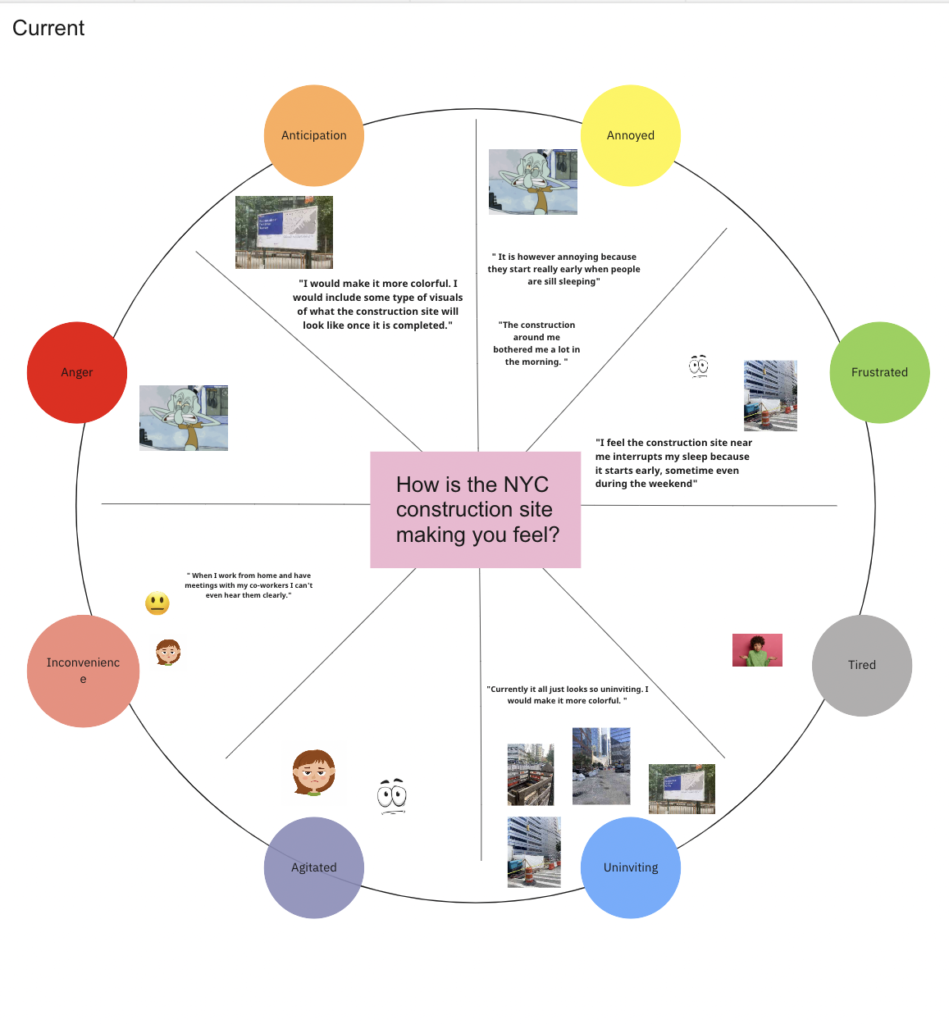
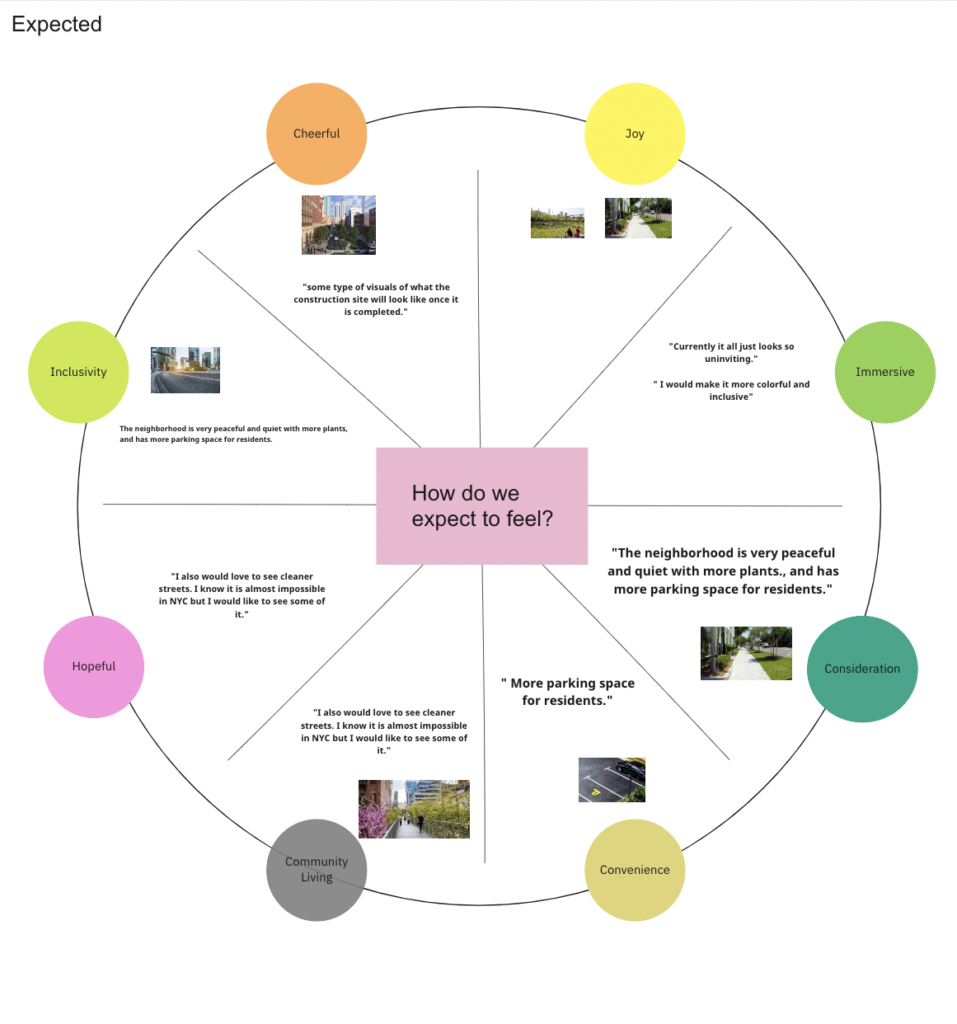
Consolidating Our Research
Exploration Of Our Research Phases
Consolidating data from all our research phases consisting of :
- Diary Study :
To learn more how people think and feel about NYC construction.
- Interviews :
Learn more about people’s experience with street construction.
- Observational Fieldwork :
Understanding the culture, norms, or social environment of an individual or group.
We summarized the our observations which we thought were the pressing matters and needed tone addressed. We provided a recommendation accordingly which, according to our research, we felt would help in bridging the gap.
Consolidating Our Research
Our First Big Idea
Residents of NYC want to be sure that their tax money is going towards bettering NYC. Being transparent about where the money goes in turn makes people feel better about the construction happening in NYC.
“Contemporary infrastructure is vital to make an area desirable to live in. If I heard the place never has construction that would be a negative because then I know my taxpayer money is not going towards bettering the place that I live in.”
-Mark, Resident Physician
“As a native New Yorker, I learned to accept construction improvements happening in NYC because I know that my tax money is going towards making NYC more beautiful/ more functional.”
–Peter, Wealth Manager
Our Recommendation
Be transparent as possible when it comes to tax payer money. People want to see that their money is actually going to good use. Maybe there’s a way to show people how much of their money is going towards the construction projects to give them an overview and directly show what kind of an impact their money will have on the betterment of various projects happening in NYC
- Graph showing money spent on completed projects.
- Interactive visual about the impact of people’s tax dollars.
Consolidating Our Research
Our Second Big Idea
Residents of NYC want to see the results of the construction project, so they can be more supportive and positive about the construction.
“Because of the construction, it is taking forever for me to find a parking spot nearby. I want to know when the construction is completed, will there be more parking space? A 3D picture of the site will be very helpful.”
–Frank, Driver working in the building near the construction site.
“I wish they could put a picture on the signage showing the results of the construction. I will be more supportive if I can see the results.”
–Kira, Graduate Student
Our Recommendation
We recommend adding a picture showing what will look like when the construction is completed. This can be added to the signage or make a visually appealing banner next to the site.
It will also be good to show the result by text, and can list several changes after the construction is completed, such as more parking space, wider sidewalk, etc.
Maybe include these information in a digital product.
Consolidating Our Research
Our Third Big Idea
We interviewed a crossing guard who works near Greenwich street construction site.
Digna is a crossing guard who works near a school area. Her main concern is safety of the children and she says “noise can be a contributing factor too”.
“Workers are speaking in Spanish. I sometimes ask what they are doing. No one tells me when it’s ended”
-Digna, A School Crossing Guard
She feels that there should be more involvement however language acts a barrier.
Our Recommendation
Since New York is a city which attracts a lot of diverse crowds. It is a known fact that a lot of people working, living and residing here speak more than one language, in this case, Digna spoke spanish. It will be helpful if the communication is provided in more than one language.
- Maybe we can have digital signs or posters that communicate in english as well as spanish
- Graphical signage helps as well as the communication is less through words and more through depiction.
Delivered Presentation
Conclusion
We consolidated our big ideas and recommendations from our research which included observational field work, interviews and diary study. We can conclude that few of the issues that are faced by people of NYC are:
- Transparency: How is our tax money being utilized , spent and benefiting us.
- Vision: How will the city look like once the construction is completed
- Language & Accessibility: How can we communicate with the diversity of New York City if my first language is not english.
This can be achieved by:
- Communicating and achieving transparency
- Sharing the vision of the improved site
- Being able to make information accessible to all